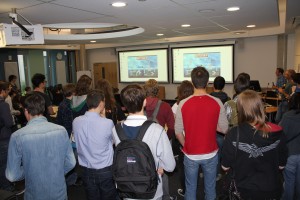| Recently I visited the University of York Computer Science department for the second year running to see the Raspberry Pi being used to great effect on the new intake of students. Last year I visited to judge Blue Pi Thinking, and since it was such a great success they decided to repeat the exercise this year. The students are sent a Raspberry Pi before they come to university, with a special build and a document that describes the challenge. There are three main reasons for doing this. The first is to give the students a common computing platform that they can use throughout the year to base different projects/assignments on. Secondly, the students will learn a great amount and will kick start their education; and finally it becomes a real social event for the students to get together (some actually help each other out) with beer and competition (which of course go hand in hand!) There are two elements to the challenge and the students can choose either (or both or neither!) The first is Blue Pi Thinking, where the challenge is to develop something creative; the second is BattlePi. BattlePi is a game of battleships played automatically by the Raspberry Pi with a server through which two Raspberry Pis can communicate. The students are given the (well commented Python) software which initially just chooses random positions to make shots at. The student then has to modify the python code to implement better AI in both firing position and ship placement. At the end of freshers’ week the students all come together (with beer of course) to test their creations. The Blue Pi Thinking creative competition whose aim is basically to create something was run as a judged event. The following are examples of projects that were created:
Throughout the year the students will be using their Raspberry Pis to continue their education, and help develop next years BattlePi competition. Will Smith and Emma Hogson, who are in charge of undergraduate admissions have offered Raspberry Pi their complete BattlePi materials including all the software and instructions so we can give it to other universities…something we’re looking into with great interest. May the worldwide BattlePi commence – watch this space! |
A Semi-automated Technology Roundup Provided by Linebaugh Public Library IT Staff | techblog.linebaugh.org
Wednesday, November 12, 2014
Let the BattlePi commence…
Subscribe to:
Post Comments (Atom)


No comments:
Post a Comment